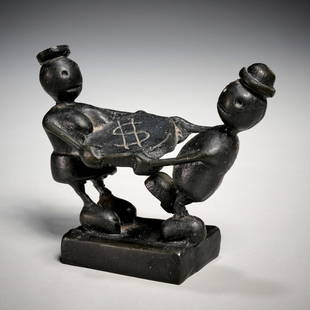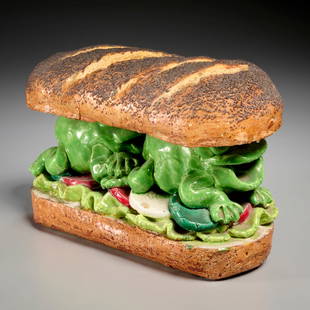
A GANDHARA TERRACOTTA BODHISATTVA WITH CURLS
Similar Sale History
View More Items in Sculptures & CarvingsRelated Sculptures & Carvings
More Items in Sculptures & Carvings
View MoreRecommended Art
View More










Item Details
Description
A GANDHARA TERRACOTTA STATUE OF A BODHISATTVA WITH MAGINIFICENT CURLS, 4th – 5TH CENTURY
Terracotta with white slip and remains of cold paint; with modern metal base
Ancient region of Gandhara, Kushan period – 4th – 5th century
TL Test confirms the dating (see further down below)
This impressive Kushan period Gandharan statue depicts a standing Bodhisattva, holding a pouch which contains the amrita nectar of immortality. Facial features and clothing display Hellenistic style, which influenced the art of Gandhara. Large eyes with enlightened expression, urna over the bridge of the nose and a gentle smile, all enhance the spiritual radiance of this Buddhist sculpture. One shoulder is bared, jewelry cuff around the upper arm, as well as on the wrist. Very fitting is the opulent, flowing hairstyle which is typical for Bodhisattva portrayals of the period.
The kingdom of Gandhara lasted from 530 BC to 1021 AD, when its last king was murdered by his own troops. It stretched across parts of present-day Afghanistan and Pakistan. Gandhara is noted for its distinctive style in Buddhist art, which developed out of a merger of Greek, Syrian, Persian and Indian artistic influence. Gandharan style flourished and achieved its peak during the Kushan period, from the 1st to the 5th century. In the first century AD, Gandhara was the birthplace of some of the earliest Buddhist images.
The use of hard-fired ceramic instead of stone such as schist was popular during the later Gandharan period from the 4th to the 6th centuries C.E. Fired clay was expensive in the area, because the wood needed for the firing process was scarce. Only very few terracotta statues from this period have ever been recorded.
Shape: Figural shape
Dimensions: 68 cm (height of sculpture alone), 28 cm (maximum width), 79 cm (height with base)
Condition: Good condition, fully consistent with the age of the sculpture, material loss to some exposed areas, crazing and hairlines visible
Provenance: From the collection of Arthur Huc (1854–1932), France. The roots of this collection go back to Evariste Regis Huc (1813 – 1860), a French missionary and discoverer who became known for his travels through Mongolia, Tibet and China. Mr. Arthur Huc became the editor-in-chief of La Dépêche in Toulouse in 1890 and was a popular political journalist and a reputed art critic until his death in 1932. In 1895 he married into the wealthy and noble Theron family from Marseille, which enabled him to expand the collection inherited from Evariste Huc. After his death, his collection was inherited by his wife, and, after her death, by their children.
Scientific testing: The Institute for Preservation Sciences at the University for Applied Arts in Vienna has confirmed the dating of the sculpture, listed above, using thermoluminescence dating.
Auction result comparison: As Gandharan terracotta artworks are very rare and hardly ever appear on the market the examples given here show various examples from the Kushan period but not the same motif. See Christie’s, Indian and Southeast Asian Art, 19 March 2013, NEW YORK, lot 212 (for a terracotta head of a bodhisattva) or Sotheby’s, IMAGES OF ENLIGHTENMENT: DEVOTIONAL WORKS OF ART AND PAINTINGS, 17 SEPTEMBER 2014, NEW YORK, lot 410 (for a terracotta head of a Buddha)
四至五世紀犍陀羅”女菩薩”陶像
紅陶,現代金屬底座
犍陀羅地區,貴霜帝國,四至五世紀
熱釋光測試證明
這是一尊令人驚豔的犍陀羅雕像。女菩薩站立,手中的壺盛裝象徵永生的秘泉水。容貌與衣飾與犍陀羅受希臘化藝術影響的風格相同。明眸大眼與充滿智慧的神情,雙眉間的白毫與慈悲的笑容,使這尊女菩薩雕像更加鮮明。一側的肩膀裸露,同時該側手臂斷裂遺失。華麗的流狀捲曲髮型是當代菩薩典型的風格。
犍陀羅王朝從西元前530至西元後1021年,最後一任國王被自己的軍隊被判。王朝位處現今的阿富汗及巴基斯坦地區。以其獨特的佛教藝術風格而聞名,該藝術由希臘,敘利亞,波斯和印度的藝術影響力合併而成。從第一至第五世紀的貴霜時期,犍陀羅風格盛行並達到鼎盛時期。在公元一世紀,犍陀羅是一些最早的佛教圖像的誕生地。
在第四世紀到第六世紀後期,犍陀羅使用硬質陶瓷代替石板(如片岩),在該地區燒製的粘土價格昂貴,因為燒製過程所需的木材稀缺。因此,這樣一個昂貴的雕塑將是一個非常有價值的佛教產品。從這個時期和規模來看,只有很少的兵馬俑雕像曾經被記錄下來。
形狀:人物形狀
尺寸:68厘米(陶像高,不含底座),28厘米(最大寬度),79厘米(含底座高度)
品相良好,完全符合當時的雕塑時代,部分材料缺失,有可見的裂痕。
來自法國的亞瑟∙胡克 (1854–1932)收藏。這位藏家的收藏足跡可追溯到 他的祖先傳教士古伯察(法語名Evariste Regis Huc 1813 – 1860), 他在他的旅行中經過蒙古,西藏和中國。亞瑟∙胡克先生1890年曾是吐魯斯報社總編,直到1932年去世,他一直是一位很受歡迎政治記者與藝術評論家。1895年他聯姻馬賽貴族家庭特隆 Theron,使他能夠繼續擴大他從古伯察繼承而來的收藏。他去世後,他妻子接收收藏,在她之後,是他們的孩子們繼承。
熱釋光測檢定:維也納工藝美術大學文物修復學院使用熱釋光測年法檢測,推斷其為年代為上方所述。
相似拍品:犍陀羅陶像極其稀有,在市場上難得發現貴霜時期的類似作品,目前還沒有發現相同陶像。見佳士得《印第安與東南亞藝術》,2013年3月19日,紐約,212號拍品(一個菩薩頭像)或蘇富比《悟相:宗教藝術專拍》,2014年9月17日,紐約,410號拍品(一個菩薩頭部陶像)。
Terracotta with white slip and remains of cold paint; with modern metal base
Ancient region of Gandhara, Kushan period – 4th – 5th century
TL Test confirms the dating (see further down below)
This impressive Kushan period Gandharan statue depicts a standing Bodhisattva, holding a pouch which contains the amrita nectar of immortality. Facial features and clothing display Hellenistic style, which influenced the art of Gandhara. Large eyes with enlightened expression, urna over the bridge of the nose and a gentle smile, all enhance the spiritual radiance of this Buddhist sculpture. One shoulder is bared, jewelry cuff around the upper arm, as well as on the wrist. Very fitting is the opulent, flowing hairstyle which is typical for Bodhisattva portrayals of the period.
The kingdom of Gandhara lasted from 530 BC to 1021 AD, when its last king was murdered by his own troops. It stretched across parts of present-day Afghanistan and Pakistan. Gandhara is noted for its distinctive style in Buddhist art, which developed out of a merger of Greek, Syrian, Persian and Indian artistic influence. Gandharan style flourished and achieved its peak during the Kushan period, from the 1st to the 5th century. In the first century AD, Gandhara was the birthplace of some of the earliest Buddhist images.
The use of hard-fired ceramic instead of stone such as schist was popular during the later Gandharan period from the 4th to the 6th centuries C.E. Fired clay was expensive in the area, because the wood needed for the firing process was scarce. Only very few terracotta statues from this period have ever been recorded.
Shape: Figural shape
Dimensions: 68 cm (height of sculpture alone), 28 cm (maximum width), 79 cm (height with base)
Condition: Good condition, fully consistent with the age of the sculpture, material loss to some exposed areas, crazing and hairlines visible
Provenance: From the collection of Arthur Huc (1854–1932), France. The roots of this collection go back to Evariste Regis Huc (1813 – 1860), a French missionary and discoverer who became known for his travels through Mongolia, Tibet and China. Mr. Arthur Huc became the editor-in-chief of La Dépêche in Toulouse in 1890 and was a popular political journalist and a reputed art critic until his death in 1932. In 1895 he married into the wealthy and noble Theron family from Marseille, which enabled him to expand the collection inherited from Evariste Huc. After his death, his collection was inherited by his wife, and, after her death, by their children.
Scientific testing: The Institute for Preservation Sciences at the University for Applied Arts in Vienna has confirmed the dating of the sculpture, listed above, using thermoluminescence dating.
Auction result comparison: As Gandharan terracotta artworks are very rare and hardly ever appear on the market the examples given here show various examples from the Kushan period but not the same motif. See Christie’s, Indian and Southeast Asian Art, 19 March 2013, NEW YORK, lot 212 (for a terracotta head of a bodhisattva) or Sotheby’s, IMAGES OF ENLIGHTENMENT: DEVOTIONAL WORKS OF ART AND PAINTINGS, 17 SEPTEMBER 2014, NEW YORK, lot 410 (for a terracotta head of a Buddha)
四至五世紀犍陀羅”女菩薩”陶像
紅陶,現代金屬底座
犍陀羅地區,貴霜帝國,四至五世紀
熱釋光測試證明
這是一尊令人驚豔的犍陀羅雕像。女菩薩站立,手中的壺盛裝象徵永生的秘泉水。容貌與衣飾與犍陀羅受希臘化藝術影響的風格相同。明眸大眼與充滿智慧的神情,雙眉間的白毫與慈悲的笑容,使這尊女菩薩雕像更加鮮明。一側的肩膀裸露,同時該側手臂斷裂遺失。華麗的流狀捲曲髮型是當代菩薩典型的風格。
犍陀羅王朝從西元前530至西元後1021年,最後一任國王被自己的軍隊被判。王朝位處現今的阿富汗及巴基斯坦地區。以其獨特的佛教藝術風格而聞名,該藝術由希臘,敘利亞,波斯和印度的藝術影響力合併而成。從第一至第五世紀的貴霜時期,犍陀羅風格盛行並達到鼎盛時期。在公元一世紀,犍陀羅是一些最早的佛教圖像的誕生地。
在第四世紀到第六世紀後期,犍陀羅使用硬質陶瓷代替石板(如片岩),在該地區燒製的粘土價格昂貴,因為燒製過程所需的木材稀缺。因此,這樣一個昂貴的雕塑將是一個非常有價值的佛教產品。從這個時期和規模來看,只有很少的兵馬俑雕像曾經被記錄下來。
形狀:人物形狀
尺寸:68厘米(陶像高,不含底座),28厘米(最大寬度),79厘米(含底座高度)
品相良好,完全符合當時的雕塑時代,部分材料缺失,有可見的裂痕。
來自法國的亞瑟∙胡克 (1854–1932)收藏。這位藏家的收藏足跡可追溯到 他的祖先傳教士古伯察(法語名Evariste Regis Huc 1813 – 1860), 他在他的旅行中經過蒙古,西藏和中國。亞瑟∙胡克先生1890年曾是吐魯斯報社總編,直到1932年去世,他一直是一位很受歡迎政治記者與藝術評論家。1895年他聯姻馬賽貴族家庭特隆 Theron,使他能夠繼續擴大他從古伯察繼承而來的收藏。他去世後,他妻子接收收藏,在她之後,是他們的孩子們繼承。
熱釋光測檢定:維也納工藝美術大學文物修復學院使用熱釋光測年法檢測,推斷其為年代為上方所述。
相似拍品:犍陀羅陶像極其稀有,在市場上難得發現貴霜時期的類似作品,目前還沒有發現相同陶像。見佳士得《印第安與東南亞藝術》,2013年3月19日,紐約,212號拍品(一個菩薩頭像)或蘇富比《悟相:宗教藝術專拍》,2014年9月17日,紐約,410號拍品(一個菩薩頭部陶像)。
Buyer's Premium
- 27%
A GANDHARA TERRACOTTA BODHISATTVA WITH CURLS
Estimate €2,500 - €5,000
12 bidders are watching this item.
Shipping & Pickup Options
Item located in Vienna, atSee Policy for Shipping
Payment

TOP









































































![[Custer, Little Big Horn] Eagle Elk, Oglala Sioux Warrior: “I was about 25 the summer we fought Long Hair and I still believed we could drive the white men from our country. I’m a little sad yet about that fight, although it was our finest victory.”](https://p1.liveauctioneers.com/7226/322253/173251540_1_x.jpg?height=310&quality=70&version=1710004847)
